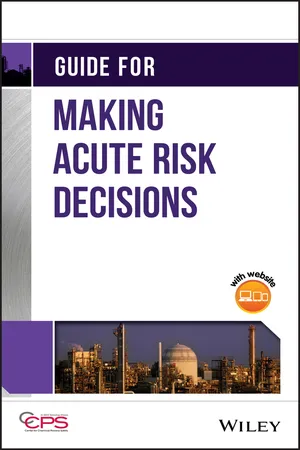
- English
- ePUB (mobile friendly)
- Available on iOS & Android
About This Book
This book presents a guidance on a large range of decision aids for risk analysts and decision makers in industry so that vital decisions can be made in a more consistent, logical, and rigorous manner. It provide good industry practices on how risk decision making is conducted in the chemical industry from many risk information sources as well as all the elements that need to be addressed to ensure good decisions are being made.
Topics Include: Identifying Risk Decisions, A Risk Decision Strategy for Process Safety, Case Studies in Risk Decision Making Failures, Guidance on Selecting Decision Aids, Templates for Decision Making in Risk-Based Process Safety, Understanding Process Hazards & Worst Possible Consequences, Management of Change as an Exercise in Risk Identification, Inherently Safer Design as an Exercise in Risk Tradeoff Analysis, Using LOPA and Risk Matrices in Risk Decisions, Using CPQRA and Safety Risk Criteria in Risk Decisions, Group Decision Making, Avoiding Decision Traps, Documentation of Process Safety Risk Decisions
Frequently asked questions
Information
1
INTRODUCTION
1.1 HISTORY OF APPROACHES TO PROCESS SAFETY MANAGEMENT
- European Union Seveso Directives, (Seveso I, 1976, Seveso II, 1997 and Seveso III, 2012)
- U.S. OSHA Process Safety Management (PSM) rule, 1992
- U.K. Offshore Installations (Safety Case) Regulations 1992
- U.S. EPA Risk Management Plan (RMP) rule, 1997
- Mexican Integral Security and Environmental Management System (SISPA), 1998
- U.K Control of Major Accident Hazards (COMAH) regulation, 1999 (COMAH is the UK implementation of the Seveso directives)
- Canadian Environmental Protection Act, 1999
- Decree 591 (China): Regulations on Safe Management of Hazardous Chemicals, 2011
- The International Association of Oil and Gas Producers (https://www.iogp.org/oil-and-gas-safety/process-safety/)
- The American Petroleum Institute (www.api.org) (https://www.api.org/news-policy-and-issues/safety-and-system-integrity)
- The Energy Institute (https://publishing.energyinst.org/topics/process-safety)
- Society of Organic Chemical Manufacturers Association http://www.socma.com/ChemStewards
1.2 THE PARADIGM OF RISK-BASED PROCESS SAFETY MANAGEMENT
1.2.1 Risk Based Process Safety (RBPS) Management
- Standards and regulations do not cover every situation
- Standards and regulations may represent the minimum that needs to be done to control risk
- Continuous improvement needs. If a company only looks at “lagging indicators”, i.e., actual incidents in which people have been hurt or killed, this could be insufficient, as they are (hopefully) rare.
Table of contents
- Cover
- Title Page
- Copyright
- ACRONYMS AND ABBREVIATIONS
- GLOSSARY
- ACKNOWLEDGEMENTS
- PREFACE
- 1 INTRODUCTION
- 2 KEY CONCEPTS IN RISK MANAGEMENT
- 3 UNDERSTANDING PROCESS HAZARDS, CONSEQUENCES AND RISKS
- 4 RISK DECISIONS AND STRATEGIES
- 5 DECISION MAKING
- 6 POTENTIAL DECISION TRAPS
- 7 INHERENTLY SAFER DESIGN
- 8 MANAGEMENT OF CHANGE
- 9 USING LOPA AND RISK MATRICES IN RISK DECISIONS
- 10 USING QRA AND SAFETY RISK CRITERIA IN RISK DECISIONS
- 11 DECISION IMPLEMENTATION
- 12 SUMMARY AND LESSONS
- REFERENCES
- INDEX
- WILEY END USER LICENSE AGREEMENT